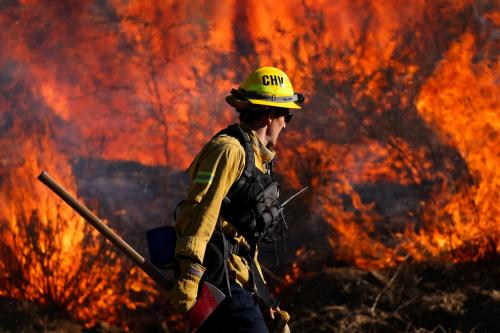EXCERPT
Climate change is expected to sharply increase the number and severity of natural disasters, displacing millions on all continents. The international community needs to recognize “disaster IDPs”—and establish new institutional arrangements to protect their human rights.
When the Guiding Principles on Internal Displacement were drafted in the 1990s, there was little consensus over whether they should include the rights of people uprooted by natural disasters. Those opposed argued that only persons fleeing persecution and violence should be considered IDPs—in other words, persons who would qualify as refugees if they crossed a border. But the majority favored including those uprooted by natural disasters because in responding to disasters, governments often discriminate against or neglect certain groups on political or ethnic grounds or overlook their human rights in other ways.
Nonetheless, not all experts, governments, international organizations and NGOs endorsed this broad formulation and even today many try to sidestep it. A report of experts to the UK government in 2005 recommended that the IDP concept be limited to persons displaced by violence because the causes and remedies of conflict-induced and disaster-induced displacement were different, making it “confusing” to include both in th IDP definition. [1] Some governments have also shied away from calling persons uprooted by natural disasters IDPs. In Aceh, Indonesia, the government preferred labelling those uprooted by the tsunami “homeless”, presumably to distinguish them from the more politicised “conflict IDPs” to whom the government had barred access. [2] In the US, government officials settled on every possible description of those uprooted by Hurricane Katrina except IDPs. They described them as “refugees”, “evacuees”, and, finally, “disaster victims”, because IDPs in their view were people displaced by conflict elsewhere. Nor does the Internal Displacement Monitoring Centre (IDMC) include people uprooted by disasters in its statistics, although it clearly acknowledges that such people are IDPs. Not dissimilarly, UNHCR made clear in 2005 that while it would serve as the lead agency for the protection of “conflict IDPs” in the UN’s new cluster approach, its role would not extend to those uprooted by disaster except “in extraordinary circumstances.”[3]
Download complete article » (external link)
[1] See Castles, S & Van Hear, N 2005, ‘Developing DFID’s Policy Approach to Refugees and Internally Displaced Persons’, Refugee Studies Centre, p12. http://tiny.cc/DFIDPolicy.
[2] Couldrey, M & Morris, T, ‘Post-tsunami protection concerns in Aceh’, Forced Migration Review, July 2005 http://www.fmreview.org/FMRpdfs/Tsunami/12.pdf.
[3] UNHCR, Internally Displaced People: Questions and Answers, September 2007 http://www.unhcr.org/basics/BASICS/405ef8c64.pdf.



Commentary
An Institutional Gap for Disaster IDPs
April 6, 2009